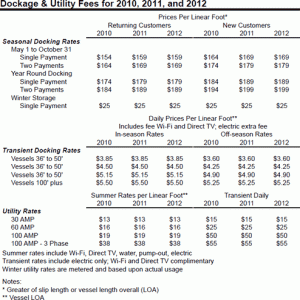Remember the old stories that date back decades about great prices for land in Florida? They’re not making any more land! Get it while it lasts! The problem was it was just swampland. Actually, let me rephrase… the problem wasn’t that it was swampland… it was just that the people who bought it didn’t do their homework! Like a marina, there was an emotional side to the deal (as pitched by the swampland superstar sales hucksters), but the ultimate responsibility was with the buyer. Let the buyer beware, so to speak.
Taking the Bull By the Horns
As I’ve said, the marina business is just that… a business. Like any business that you are starting or restarting, you begin by planning. I won’t get into management or operational plans… it’s not my forte. What is more important is getting your financial projections as accurate as possible. By that I mean things like how many slips will you fill, what will you charge, what will your operating expenses be and what start-up expenses will you have to incur. Ah… but this is only the beginning of your journey and search for wisdom, young grasshopper!
 Having done my share of marina feasibility studies and read others, there is one element that is typically too cost prohibitive to be included but that you, as a prospective purchaser, really should consider. It’s the part where you go beyond quantifying demand and asking the market directly what it wants. It’s the part where you ask boaters in neighboring marinas their opinion of the dark marina.
Having done my share of marina feasibility studies and read others, there is one element that is typically too cost prohibitive to be included but that you, as a prospective purchaser, really should consider. It’s the part where you go beyond quantifying demand and asking the market directly what it wants. It’s the part where you ask boaters in neighboring marinas their opinion of the dark marina.
What you want to determine is if the marina has stigma. Will people stay away from it because it went dark? If so for how long? The best and easiest customers to get are those that were there before, but do they view the marina as stigmatized? A lot depends on how long the marina was dark.
The other part of the equation is how the prior owner ran their business. If the boater was always at the short end of the stick, you might be walking into something that will take a long time to fix.
Quantifying demand is probably the hardest research task you will have. It’s also the most important. With cash flow you have options. Without it good luck. Talking to prospective boaters at neighboring marinas is how you will find out what they think about the marina, if they could be enticed to switch to it, what services the marina lacked to be competitive, what physical problems it might have and a host of other valuable information. Your demand will be based on several things:
- How much vacancy exists in the immediate area. A 20 or 30 percent vacancy means you’ll have to be very aggressive on price to fill up anywhere near market (a painful 20 or 30 percent vacancy, remember).
- What slip rental rates you should set.
- What services are provided with your slip rental rates (if they’re not present, you’ll need to go even lower in price).
- What services and features boaters demand the most that you must absolutely provide to attract customers (for instance, one of the top demands of boaters is clean, functioning, adequate bathrooms; another is a safe environment where things on their boat won’t get stolen and it won’t get vandalized).
Another advantage of talking to boaters at competitive marinas is they can provide you insight into what is missing in the market that you might be able to provide in the future. You can make it part of your long-range plan, but I caution you against basing any part of your purchase decision on it. There are just too many variables in the short term. Remember… you don’t own the thing yet.
This isn’t a hard task and it shouldn’t slow up the deal. You can do it over a weekend. It’s not like the Real Estate Owned (REO) department is working Saturday or Sunday. The old adage “time is money” has a new spin, doesn’t it?
Timing
It may sound strange, but what time of year you buy the marina has a key effect on its profitability and your return on investment. If the marina is located in a seasonal area, if you buy it after the beginning of season booking is over you may be looking at a very low peak season demand. You may have to be really aggressive on your rates because if the market has annual booking contracts, you can forget about luring boaters away. You’ll have to generate your own demand from outside. When you combine that with start-up operational cash requirements and maybe some money invested back into the marina, you have to be very careful in planning your cash flow.
Let’s Talk Investment
In Part 4 I’ll talk about some key investment and value indicators and how they apply to dark marinas.

